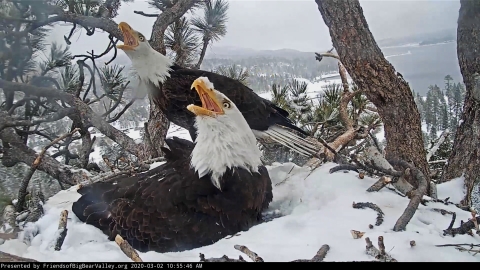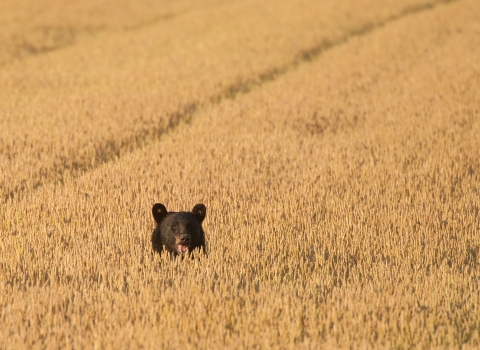We at the U.S. Fish and Wildlife Service know that eagles are fascinating and fun to watch. Sometimes eager wildlife enthusiasts take their observations a bit too far. One emerging threat to eagles and other wildlife is an increase in harassment from uncrewed aircraft systems, commonly referred to as drones or the shorthand abbreviation, UAS. We need your help to keep eagles safe as they nest and raise young. Take a few moments to learn what special protections eagles have under federal law, how you can view them safely and what to do if you see someone harassing eagles or other wildlife.
Bald eagles are more than conceptual symbols of freedom and strength. As a population, they have rebounded from the brink of extinction. In the early 1960s, there were estimated to be as few as 417 nesting pairs in the lower 48 states. By comparison, there are more than 71,000 nesting pairs today. While eagle success is partly due to strong environmental laws, it’s also due to their tenacity and adaptability as a species. Today, they can be found in almost every state and thriving in all sorts of habitats.
Eagle protections
Even though eagles are no longer an endangered species, they are still protected by several federal laws, including the Bald and Golden Eagle Protection Act, the Migratory Bird Treaty Act and the Lacey Act, as well as other state and municipal protections. Eagles, including feathers and parts, nests, nest trees, as well their winter or nighttime roosts, are all protected by federal laws. Even with all these protections, eagles suffer from harassment, especially during the stressful time of nesting. Drone use and other invasive human activities can cause breeding pairs to abandon nests for the season. This is an actionable offense that can result in heavy fines and even prison time.
Winter is prime time for nesting
While you might think of eagles as independent and solitary by nature, they can be incredibly vulnerable, especially while nesting. You also might not realize that courtship and nesting starts much earlier than many other resident or migratory birds. While the breeding season varies regionally and from year to year, it can begin as early as November and December in southern areas. Eagles in colder climates typically begin building or improving nests in January and may lay eggs as early as mid-February. Males and females share parental duties – from incubating eggs and feeding young, to protecting the nest and teaching fledglings to find their own food. It’s essential that we give eagles a respectful distance during this time and that we’re thoughtful about how our actions may impact them. Eagles and many other raptors are territorial when nesting and may perceive drones and other loud equipment as a threat, resulting in serious consequences – from lost energy defending their nest and egg failure, to eaglet death and potential injury to the adult birds.
How close is too close?
Under federal law, it is illegal to pursue, shoot, shoot at, poison, wound, kill, capture, trap, collect, destroy, molest or disturb eagles – including getting too close. For most human activities like tree clearing, road work and construction, we recommend a 660-foot buffer around an active eagle nest during the breeding season. However, there is no known safe distance to observe eagles or their nests with drones. It is also illegal to trail or pace an eagle with a drone while the eagle is in flight, regardless of location or time of year.
While the U.S. Fish and Wildlife Service does not oversee or manage the use of drones in general, we cannot approve any management plans or proposals that involve using drones for surveying eagles or their nests. You can be prosecuted if harassment of an eagle, or other wildlife, occurs while flying a drone. We recommend wildlife observers follow the provisions described in the Airborne Hunting Act.
Because of the uncertainty around the safety of drones, the Department of the Interior currently only uses drones for emergency situations. Additionally, due to concerns around harassment of wildlife, drone use is prohibited on national wildlife refuges.
Legal penalties
Not only can people potentially cause an eagle pair to abandon an active nest for the breeding season, which causes egg failure or the death of chicks, they can lose expensive equipment to a defensive eagle attack. These actions can result in expensive penalties under multiple federal, state and tribal laws. Under the Bald and Golden Eagle Protection Act, the first criminal offense is a misdemeanor with a maximum penalty of one year in prison and a $100,000 fine for an individual or a $200,000 fine for an organization. The second offense becomes a felony, with a maximum penalty of two years in prison and a $250,000 fine for an individual or a $500,000 fine for an organization. The act also provides for maximum civil penalties of $5,000 for each violation.
Help protect wildlife
We encourage you to get outdoors and get to know your local wildlife from a safe distance. If you see someone who may be harassing wildlife, contact your local game warden, or send us an email with all related information or call our tip line at 1-844-FWS-TIPS (1-844-397-8477).
Many of our law enforcement investigations are solved because people who see unlawful activities reach out to law enforcement. Wildlife crime is far more domestic than you may realize, and it can happen in your local parks, national wildlife refuges and even on your own land. You can help make a difference.






